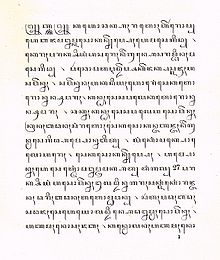There are three main groups of Javanese
dialects based on the sub region where the speakers live. They are: Western Javanese, Central Javanese and Eastern Javanese. The differences between these dialectical groups are primarily pronunciation and, to a lesser extent, vocabulary. All Javanese dialects are more or less mutually intelligible.
The Central Javanese variant, based on the speech of
Surakarta (and also to a degree of
Yogyakarta), is considered as the most "refined" Javanese dialect. Accordingly standard Javanese is based on this dialect. These two cities are the seats of the four Javanese principalities, heirs to the Mataram Sultanate, which once reigned over almost the whole of Java and beyond. Speakers spread from north to south of the
Central Java province and utilize many dialects, such as
Muria and
Semarangan, as well as
Surakarta and
Yogyakarta. To a lesser extent, there are also dialects such as those used in
Pekalongan or
Dialek Pantura and
Kebumen (a variation of
Banyumasan). The variations of Javanese dialect in Central Java are said to be so plentiful that almost all administrative regions have their own native
slang that is only recognizable by people from that region, but those minor dialects are not distinctive to most Javanese speakers.
In addition to Central Java and Yogyakarta provinces, Central Javanese is also used in the western part of East Java province. For example, Javanese spoken in the
Madiun region bears a strong influence of Surakarta Javanese (as well as Javanese spoken in
Ponorogo,
Pacitan, and
Tulungagung), while Javanese spoken in
Bojonegoro and
Tuban is similar to that spoken in the Pati region (
Muria dialect).
Western Javanese, spoken in the western part of the Central Java province and throughout the
West Java province (particularly in the north coast region), contains dialects which are distinct for their
Sundanese influences and which still maintain many archaic words. The dialects include
North Banten,
Banyumasan,
Tegal,
Jawa Serang,
North coast,
Indramayu (or
Dermayon) and
Cirebonan (or
Basa Cerbon).
Eastern Javanese speakers range from the eastern banks of
Kali Brantas in
Kertosono to
Banyuwangi, comprising the majority of the
East Java province, excluding
Madura island. However, the dialect has been influenced by
Madurese, and is sometimes referred to as
Surabayan speech.
The most aberrant dialect is spoken in Balambangan (or
Banyuwangi) in the eastern-most part of Java. It is generally known as
Basa Osing.
Osing is the word for negation and is a cognate of the
Balinese tusing, Balinese being the neighboring language directly to the east. In the past this area of Java was in possession of Balinese kings and warlords.
In addition to these three main Javanese dialects, there is
Surinamese Javanese. Surinamese Javanese is mainly based on the Central Javanese dialect, especially from the
Kedu residency.
Pronunciation
Most Javanese people, except those who live in West Java, accept the pronunciation of the phoneme "a" as /ɔ/. Therefore, there is a different pronunciation of many words; for example
apa (Eng.=what) is pronounced /apaʔ/ in Western Javanese and /ɔːpɔː/ in Central and Eastern Javanese.
When there is a condition of phoneme stem VCV (Vowel-Consonant-Vowel) with the same vowels, Central Javanese speakers drop the second vowel into another sound, with the following formula: "i" becomes /e/ and "u" becomes /o/, the Easterns drop both of the vowels, whereas Western Javanese maintains the sounds "i" and "u". So the word
cilik (Eng.= small), is pronounced
/tʃileʔ/ in Central,
/tʃeːleʔ/ in Eastern, and
/tʃilik/ in Western Javanese; the word
tutup is pronounced
/tutop/ in Central,
/toːtop/ in Eastern, and
/tutup/ in Western Javanese.
Vocabulary
The vocabulary of Javanese language is enriched by dialectal words. For example, to get the meaning of "you", Western Javanese speakers say
rika /rikaʔ/, Eastern Javanese use
kon /kɔn/, and Central Javanese speakers say
kowe /kowe/. Another example is the expression of "how": the Tegal dialect of Western Javanese uses
kepriben /kəpriben/, the
Banyumasan dialect of Western Javanese employs
kepriwe /kəpriwe/ or
kepriwen /kəpriwen/, Eastern Javanese speakers say
yok apa /jɔʔ ɔpɔ/ - originally means "like what" (Javanese: kaya apa), and Central Javanese speakers say
piye /piye/.



